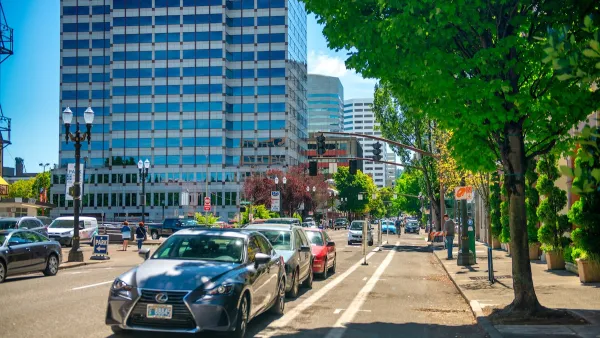While critiquing one of my blog posts, Prof. Randall Crane asked: "Is any parking regulation a net social burden or only 1.75 spaces per Jacksonville, Florida apartment?" This question in turn is an example of a broader question: how do we resolve an issue when we don’t know, and perhaps have no way of knowing, the ideal empirical answer? Parking regulation presents a classic example: looking at environmental harm alone, it seems to me clear that minimum parking requirements create some environmental harm by on balance encouraging driving, but also reduce environmental harm from "cruising" (motorists wasting time and fuel searching for parking spaces).*
While critiquing one of my blog posts, Prof. Randall Crane asked: "Is any parking regulation a net social burden or only 1.75 spaces per Jacksonville, Florida apartment?" This question in turn is an example of a broader question: how do we resolve an issue when we don't know, and perhaps have no way of knowing, the ideal empirical answer?
Parking regulation presents a classic example: looking at environmental harm alone, it seems to me clear that minimum parking requirements create some environmental harm by on balance encouraging driving, but also reduce environmental harm from "cruising" (motorists wasting time and fuel searching for parking spaces).*
But like Crane, I'm not sure if there's any way to quantify these consideration in a way that gives us the ideal number of parking spaces for a given use. So how do we break the tie where empirical data is scanty?
Generally, local governments seem to use traffic flow as the tie-breaking principle: when in doubt about the empirical consequences of a policy, choose the answer that helps the greatest number of vehicles move the greatest number of miles as speedily as possible. Having lived in places where government consistently follows this principle, I am not particularly satisfied with the results, because I believe the "traffic flow first" principle involves other important values. In particular:
*The tie goes to freedom. Where the factual results of policy alternatives are unclear, I tend to favor the solution that involves the least government regulation, because I believe that negative freedom- that is, freedom from government intrusion- is a useful value.
*The tie goes to (positive) freedom. Where the facts are unclear, I favor maximizing positive freedom, by which I mean increasing the level of transportation choice. Where walking and bicycling are so uncomfortable as to be impractical for sane people, consumer choices are limited. In less car-dependent environments, consumer choices are increased.
*The tie goes to equality. Where the facts are unclear, I favor the solution that aids those too young, disabled or needy to drive, as opposed to the solution that aids the rich and the middle class at the expense of the poor.
In many situations, these values are in conflict. For example, urban growth boundaries may increase positive freedom (by making city living a more practical choice) yet reduce negative freedom by increasing government regulation of land use. And their impact on equality is unclear: on the one hand, growth controls might increase real estate prices (bad) but where a region's poor live in cities and older suburbs, growth boundaries might, by saving such municipalities from being hollowed out, increase the tax base available for serving the poor (good) and increase the number of jobs within commuting distance of the urban poor (also good).
But parking presents none of these tough calls. By favoring drivers at the expense of (mostly poorer) nondrivers, minimum parking requirements are anti-equality and anti-positive freedom. By inconveniencing landowners, minimum parking requirements reduce negative freedom. Hence, where empirical knowledge is scarce, my inclination is to eliminate such regulations.
*See my blog post at http://www.planetizen.com/node/44907 for a more extensive discussion.

Maui's Vacation Rental Debate Turns Ugly
Verbal attacks, misinformation campaigns and fistfights plague a high-stakes debate to convert thousands of vacation rentals into long-term housing.

Planetizen Federal Action Tracker
A weekly monitor of how Trump’s orders and actions are impacting planners and planning in America.

Chicago’s Ghost Rails
Just beneath the surface of the modern city lie the remnants of its expansive early 20th-century streetcar system.

Bend, Oregon Zoning Reforms Prioritize Small-Scale Housing
The city altered its zoning code to allow multi-family housing and eliminated parking mandates citywide.

Amtrak Cutting Jobs, Funding to High-Speed Rail
The agency plans to cut 10 percent of its workforce and has confirmed it will not fund new high-speed rail projects.

LA Denies Basic Services to Unhoused Residents
The city has repeatedly failed to respond to requests for trash pickup at encampment sites, and eliminated a program that provided mobile showers and toilets.
Urban Design for Planners 1: Software Tools
This six-course series explores essential urban design concepts using open source software and equips planners with the tools they need to participate fully in the urban design process.
Planning for Universal Design
Learn the tools for implementing Universal Design in planning regulations.
planning NEXT
Appalachian Highlands Housing Partners
Mpact (founded as Rail~Volution)
City of Camden Redevelopment Agency
City of Astoria
City of Portland
City of Laramie





























